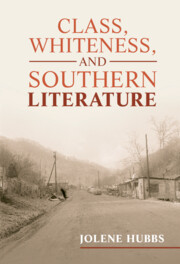Book contents
- Class, Whiteness, and Southern Literature
- Cambridge Studies in American Literature and Culture
- Class, Whiteness, and Southern Literature
- Copyright page
- Contents
- Figures
- Acknowledgments
- Introduction
- Chapter 1 Riffraff and Half-Strainers
- Chapter 2 Slow, Sweating, Stinking Bumpkins
- Chapter 3 Civil Rights and Uncivil Whites
- Chapter 4 Hungry Women and Horny Men
- Coda
- Notes
- Bibliography
- Index
- Recent books in this series (continued from page ii)
Chapter 3 - Civil Rights and Uncivil Whites
Flannery O’Connor and Southern Women’s Midcentury Writing
Published online by Cambridge University Press: 01 December 2022
- Class, Whiteness, and Southern Literature
- Cambridge Studies in American Literature and Culture
- Class, Whiteness, and Southern Literature
- Copyright page
- Contents
- Figures
- Acknowledgments
- Introduction
- Chapter 1 Riffraff and Half-Strainers
- Chapter 2 Slow, Sweating, Stinking Bumpkins
- Chapter 3 Civil Rights and Uncivil Whites
- Chapter 4 Hungry Women and Horny Men
- Coda
- Notes
- Bibliography
- Index
- Recent books in this series (continued from page ii)
Summary
Chapter three looks at works written during the civil rights era to understand how and why the poor white southerner entered the national spotlight as the face of racism in this era. In this part, I probe the disconnect between the period’s activism and its literature—in other words, I work to make sense of why at the very moment that black civil rights activists were taking on the Board of Education of Topeka, Kansas, the public transit system of Montgomery, Alabama, and other discriminatory institutions, midcentury southern white women writers were depicting acts of racism perpetrated by isolated individuals located on the ragged margins of southern society. Using evidence from her fictional works as well as her correspondence, I propose that Flannery O’Connor broke rank with her celebrated contemporaries. In her short stories, O’Connor took up specific formal techniques that Harper Lee, Lillian Smith, and Eudora Welty used to depict diabolical poor white men and redeployed them to expose the social blight her contemporaries were at pains to obscure: middle-class racism.
- Type
- Chapter
- Information
- Class, Whiteness, and Southern Literature , pp. 68 - 93Publisher: Cambridge University PressPrint publication year: 2022

